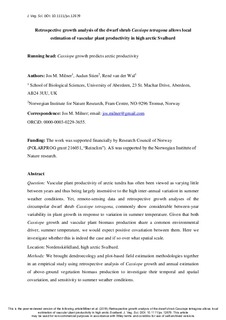| dc.contributor.author | Milner, Jos M. | |
| dc.contributor.author | Stien, Audun | |
| dc.contributor.author | Wal, Rene van der | |
| dc.coverage.spatial | Nordenskiöldland,higharcticSvalbard | nb_NO |
| dc.date.accessioned | 2018-11-19T14:29:32Z | |
| dc.date.available | 2018-11-19T14:29:32Z | |
| dc.date.created | 2018-10-25T13:24:20Z | |
| dc.date.issued | 2018 | |
| dc.identifier.issn | 1100-9233 | |
| dc.identifier.uri | http://hdl.handle.net/11250/2573599 | |
| dc.description.abstract | Question: Vascular plant productivity of arctic tundra has often been viewed as varying little between years and thus being largely insensitive to the high inter-annual variation in summer weather conditions. Yet, remote-sensing data and retrospective growth analyses of the circumpolar dwarf shrub, Cassiope tetragona, commonly show considerable between-year variability in plant growth in response to variation in summer temperature. Given that both Cassiope growth and vascular plant biomass production share a common environmental driver, summer temperature, we would expect positive co-variation between them. Here we investigate whether this is indeed the case and if so over what spatial scale. Location: Nordenskiöldland, high arctic Svalbard. Methods: We brought dendroecology and plot-based field estimation methodologies together in an empirical study using retrospective analysis of Cassiope growth and annual estimation of above-ground vegetation biomass production to investigate their temporal and spatial co-variation and sensitivity to summer weather conditions. Results: Despite substantial small-scale heterogeneity, we found spatial co-variation in Cassiope growth patterns, which weakened as distance between sampling sites increased from 0 to 25 km. Furthermore, we found a strong positive correlation between annual estimates of above-ground live vascular plant biomass and Cassiope shoot growth over a 12-year period at a local scale. The correlation declined with distance, likely due to increasing differences in local weather conditions. Conclusions: We demonstrate that Cassiope growth can be used as a proxy for above-ground tundra vegetation productivity at the local scale. Our findings suggest that Arctic plant productivity is as sensitive to between-year variation in summer temperature as the well-established growth response of Cassiope. This challenges the view that tundra plant productivity varies little between years and provides a mechanistic understanding that helps reconcile field-and satellite-based annual estimation methods. K E Y W O R D S Arctic bell-heather, arctic climate change, Cassiope tetragona, dendrochronology, plant– climate interaction, spatial scale, Svalbard, tundra vegetation, vascular plant productivity, vegetation biomass | nb_NO |
| dc.language.iso | eng | nb_NO |
| dc.title | Retrospective growth analysis of the dwarf shrub Cassiope tetragona allows local estimation of vascular plant productivity in high arctic Svalbard | nb_NO |
| dc.title.alternative | Retrospective growth analysis of the dwarf shrub Cassiope tetragona allows local estimation of vascular plant productivity in high arctic Svalbard | nb_NO |
| dc.type | Journal article | nb_NO |
| dc.type | Peer reviewed | nb_NO |
| dc.description.version | acceptedVersion | nb_NO |
| dc.rights.holder | © 2018 International Association for Vegetation Science | nb_NO |
| dc.subject.nsi | VDP::Zoologiske og botaniske fag: 480 | nb_NO |
| dc.subject.nsi | VDP::Zoology and botany: 480 | nb_NO |
| dc.source.journal | Journal of Vegetation Science | nb_NO |
| dc.identifier.doi | 10.1111/jvs.12679 | |
| dc.identifier.cristin | 1623499 | |
| dc.relation.project | Norges forskningsråd: 216051 | nb_NO |
| cristin.unitcode | 7511,4,0,0 | |
| cristin.unitname | Tromsø | |
| cristin.ispublished | true | |
| cristin.fulltext | postprint | |
| cristin.qualitycode | 1 | |
